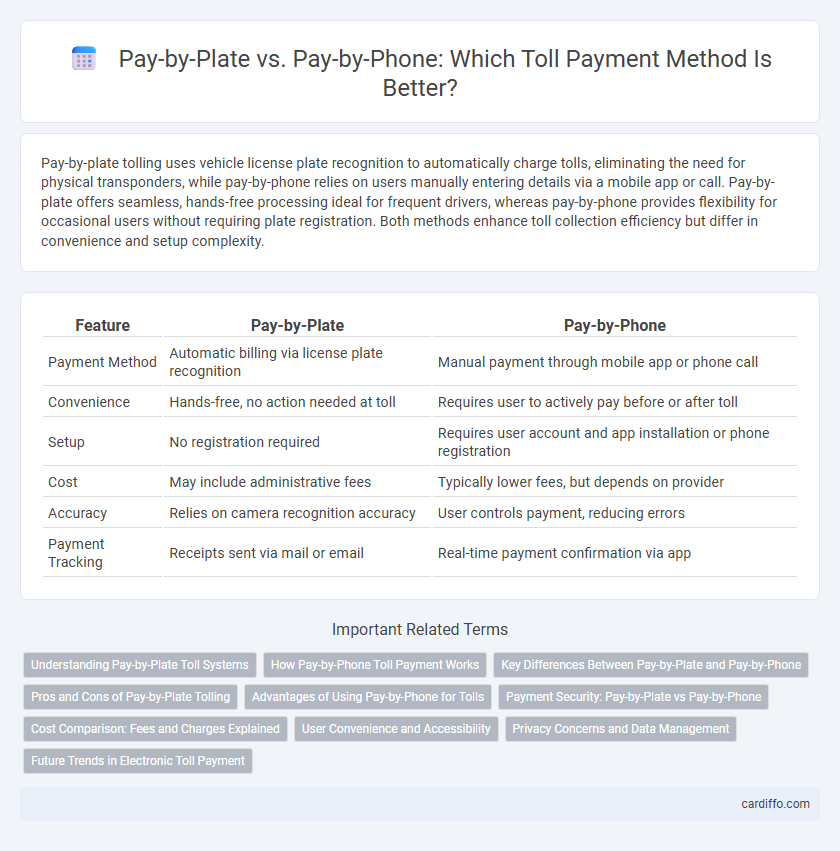Pay-by-plate tolling uses vehicle license plate recognition to automatically charge tolls, eliminating the need for physical transponders, while pay-by-phone relies on users manually entering details via a mobile app or call. Pay-by-plate offers seamless, hands-free processing ideal for frequent drivers, whereas pay-by-phone provides flexibility for occasional users without requiring plate registration. Both methods enhance toll collection efficiency but differ in convenience and setup complexity.
Table of Comparison
| Feature | Pay-by-Plate | Pay-by-Phone |
|---|---|---|
| Payment Method | Automatic billing via license plate recognition | Manual payment through mobile app or phone call |
| Convenience | Hands-free, no action needed at toll | Requires user to actively pay before or after toll |
| Setup | No registration required | Requires user account and app installation or phone registration |
| Cost | May include administrative fees | Typically lower fees, but depends on provider |
| Accuracy | Relies on camera recognition accuracy | User controls payment, reducing errors |
| Payment Tracking | Receipts sent via mail or email | Real-time payment confirmation via app |
Understanding Pay-by-Plate Toll Systems
Pay-by-plate toll systems use automated license plate recognition technology to capture vehicle information, allowing seamless toll payments without stopping. This method reduces congestion and eliminates the need for physical transponders, offering a convenient alternative to pay-by-phone systems that require manual input of license plate numbers or account details. Understanding the accuracy, privacy implications, and integration capabilities of pay-by-plate systems helps drivers choose the most efficient toll payment option.
How Pay-by-Phone Toll Payment Works
Pay-by-phone toll payment uses a mobile app linked to a vehicle's license plate or account, enabling automatic toll deduction without stopping at toll booths. Drivers register their vehicle and payment method, then simply drive through toll points while the system captures and processes the toll charges in real-time. This method reduces congestion, minimizes human error, and provides digital records for easy expense management.
Key Differences Between Pay-by-Plate and Pay-by-Phone
Pay-by-plate toll systems use automatic license plate recognition to identify vehicles and charge tolls without requiring driver interaction, enhancing convenience and reducing tollbooth congestion. Pay-by-phone requires users to manually enter their vehicle information and toll location via a mobile app or call, offering flexibility but relying on pre-registration and real-time user input. Key differences include automation level, ease of use, and dependency on driver participation, with pay-by-plate systems generally providing a seamless, contactless experience compared to the more hands-on pay-by-phone method.
Pros and Cons of Pay-by-Plate Tolling
Pay-by-plate tolling offers the convenience of automatic license plate recognition, eliminating the need for transponders and reducing physical interactions at toll points. However, this system can incur higher fees due to billing and administrative costs, and the risk of misread plates may lead to incorrect charges or violations. Despite its ease of use, pay-by-plate requires vehicle owners to maintain updated registration information to avoid penalties and ensure accurate billing.
Advantages of Using Pay-by-Phone for Tolls
Pay-by-phone offers real-time payment confirmation and account management, reducing the risk of toll violations due to missed payments. This method allows users to easily track toll expenses and receive electronic receipts, enhancing transparency and record-keeping. Mobile apps provide convenience with features like auto-replenishment and route planning, making toll payments seamless and efficient.
Payment Security: Pay-by-Plate vs Pay-by-Phone
Pay-by-Phone systems utilize encrypted mobile applications with multi-factor authentication, significantly enhancing payment security by reducing the risk of unauthorized access and fraud. Pay-by-Plate relies on license plate recognition technology, which can be vulnerable to plate cloning and lacks real-time authentication protocols, potentially exposing users to payment disputes. Integrating tokenization and secure APIs in Pay-by-Phone platforms ensures encrypted transactions and compliance with PCI DSS standards, offering superior protection compared to the image-based verification in Pay-by-Plate systems.
Cost Comparison: Fees and Charges Explained
Pay-by-plate toll systems typically involve a base toll fee plus administrative charges that can range from $2 to $5 per transaction, reflecting the cost of license plate recognition and billing. Pay-by-phone services often charge a convenience fee around $1 to $2 per use, on top of the standard toll, which covers app maintenance and real-time transaction processing. Comparing overall expenses, pay-by-plate methods may result in higher cumulative fees due to delayed billing and potential penalties, whereas pay-by-phone offers more immediate payment with slightly lower administrative costs.
User Convenience and Accessibility
Pay-by-plate systems enhance user convenience by eliminating the need for physical payment devices, allowing seamless toll access through vehicle license recognition. Pay-by-phone options offer accessibility with mobile app interfaces, enabling real-time account management and payment verification from anywhere. Both methods reduce the risk of toll violations by providing flexible, contactless payment choices tailored to diverse user preferences.
Privacy Concerns and Data Management
Pay-by-plate systems capture and store license plate images linked to vehicle and payment data, raising concerns over long-term data retention and potential unauthorized access. Pay-by-phone methods centralize payment information within secure apps, limiting exposure of vehicle details but requiring trusted handling of personal financial data. Both systems demand robust encryption and strict privacy policies to protect user information and comply with data protection regulations.
Future Trends in Electronic Toll Payment
Future trends in electronic toll payment emphasize increasing adoption of pay-by-plate systems, leveraging advanced license plate recognition technology for seamless transactions and reduced roadside infrastructure costs. Pay-by-phone methods remain popular due to user convenience and app integration, but ongoing enhancements in mobile payment security and real-time account management are expected to drive further growth. Integration of AI and IoT with these systems aims to optimize traffic flow and enable dynamic pricing models, enhancing tolling efficiency and user experience across urban and interstate networks.
Pay-by-plate vs Pay-by-phone Infographic

 cardiffo.com
cardiffo.com